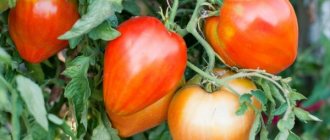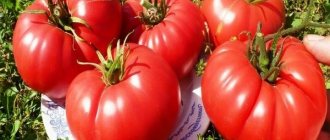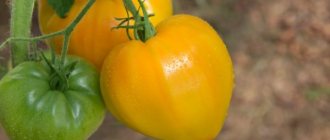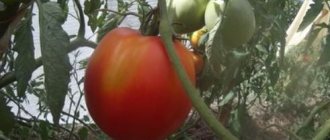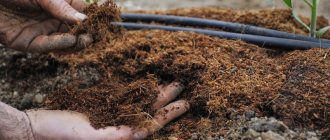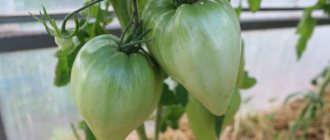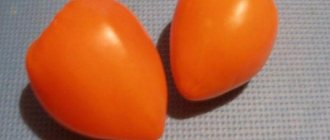The orange oxheart tomato is a variety for those who want to get high yields and have amazingly tasty and equally healthy fruits on the table for 1.5 months. Recommended for cultivation in both warm and cold regions of Russia - in Siberia and the Urals.
| Height | Landing location | Ripening time | Fruit color | Fruit size | Origin | Fruit shape |
| Tall | Greenhouse, Open ground | Mid-season | Orange | Large | Hybrid | Heart-shaped |
Features and description of the variety
The Oxheart Orange tomato variety is a very popular F1 hybrid. It was created by breeders in 2003. This variety is characterized by high yield and average fruit ripening time. From planting to full ripeness of the fruit, it takes from 125 to 130 days. The peculiarity of the variety is that fruits of different sizes and shapes grow on one bush. The tomatoes on the bottom ones are large and flat, on the top ones the fruits weigh up to 100 g and are more round in shape. The height of the bush is 1.5-1.8 m. The plant is resistant to many diseases, but is sensitive to late blight. The leaf of the plant is medium in size, dark green in color. In terms of taste characteristics, this vegetable is most similar to varieties of Mediterranean tomatoes.
Characteristics
Tomatoes "Oxheart orange" have the following advantages:
- excellent taste and commercial characteristics of the fruit;
- drought resistance;
- good yield;
- large-fruited.
The disadvantages of these tomatoes include their susceptibility to such a dangerous disease as late blight, and also the fact that they are not suitable for canning.
Bull's Heart Orange tomatoes are characterized by the formation of the first inflorescence above the first leaf. One cluster most often contains five or six fruits. Fruits can differ not only in weight, but also in shape. The largest fruits are usually located on the lower clusters.
You can compare the yield of this variety with others in the table below:
| Variety name | Productivity |
| Bull heart orange | 5-20 kg per bush |
| Bobcat | 4-6 kg per bush |
| Rocket | 6.5 kg per square meter |
| Russian size | 7-8 kg per square meter |
| Premier | 6-9 kg per square meter |
| King of Kings | 5 kg per bush |
| Stolypin | 8-9 kg per square meter |
| Long Keeper | 4-6 kg per bush |
| Black bunch | 6 kg per bush |
| Grandma's gift | 6 kg per square meter |
| Brawler | 9 kg per bush |
On our website you will find a lot of useful information on how to properly grow tomato seedlings. Read all about planting seedlings at home, how long after planting the seeds sprout and how to water them correctly. And also how to grow tomatoes in twists, upside down, without soil, in bottles and using Chinese technology.
Productivity
The tomatoes are large, weighing on average 200-300 grams. The shape of the fruit is round, slightly pointed. The tomato has slight ribbing at the stalk. The color of the tomato when ripe is yellow-orange. The fruit is juicy, fleshy, with a small number of seeds. The tomato has a rich but pleasant sweetish taste. Due to its nutritional qualities, this tomato is recommended for use in baby food. From one bush of "Bull's Heart Orange" you can harvest about 5 kg. In greenhouse conditions, the yield increases to 12 kg.
Caring for tomatoes in the open ground and in the greenhouse
The need for regular and careful care is considered one of the main disadvantages of the Bull's Heart variety. But for the sake of large and wonderfully tasty fruits, gardeners are ready to endure even more.
Watering
Tomatoes Ox's heart, if the weather is not too hot outside, water at intervals of 4-5 days. As the bush grows, the norm is gradually increased from 5–7 liters per plant to 10–12 liters by the time of flowering. In hot weather, water more abundantly, up to 15 liters. The best time for the procedure is early morning or late evening. Only warm, settled water is used. The leaves of bushes that lack water darken and droop, curling along the central vein.
Recent Entries
5 working ways to use tar in the garden 7 indoor plants that help you get married even in adulthood Indoor plants that can bloom in trouble
The most preferred method for Oxheart is drip irrigation. It allows you to deliver water directly to the roots without eroding the soil. If it is not technically possible to organize such a system, water in circular grooves around the base of the stem or along longitudinal grooves between rows. Sprinkling for crops is a completely unsuitable option. Drops of water falling on the plant provoke massive shedding of buds, flowers and fruit ovaries. They also spread pathogens of many fungal diseases; in a greenhouse they can cause sunburn. And if you pour water under the roots from a watering can or hose, the substrate is quickly washed off from them, they become bare and dry out.
The ideal option for any variety of tomatoes is drip irrigation
In a greenhouse, in addition to sufficient soil moisture, you will also have to monitor the level of air humidity. The Bull's Heart variety is moisture-loving, but this applies only to the soil, not the atmosphere. For the latter, the optimal figure is 65–70%. Therefore, every time after watering, the greenhouse must be ventilated. Cover the container with water in it with a lid. The room temperature is maintained at 22–25°C during the day and 16–20°C at night.
When growing tomatoes in a greenhouse, in addition to the level of soil moisture, you will also have to monitor air humidity
Proper watering is especially important during the formation of fruit ovaries. A lack of moisture provokes their massive fall. And about a month before harvest, it is recommended to reduce it to the required minimum. Otherwise, the fruits of the Ox Heart will turn out watery, and the pulp will not acquire the characteristic taste of the variety.
Irrigation from a watering can, hose and any other method of watering in which drops of water fall on the bush are absolutely not suitable for tomatoes
This tomato demonstrates good drought resistance, but it’s still not worth experimenting with. If you do not have the opportunity to permanently live in the garden, mulch the soil. It is also extremely harmful to alternate periods of prolonged drought with rare but abundant watering. This provokes massive cracking of the fruit.
Video: tips for cultivating tomatoes in open ground
Fertilizer application
The Oxheart tomato requires increased doses of nutrients throughout the growing season. The type of fertilizer does not matter; bushes respond equally well to both organic and mineral fertilizers. They are applied every 12–15 days.
The bushes are fertilized for the first time 2–2.5 weeks after planting in a permanent place. During the first month, Oxheart tomatoes need nitrogen. This macronutrient helps the bushes actively grow green mass. In the future, it should be abandoned completely. Excess nitrogen in the soil increases the risk of infection by pathogenic fungi, inhibits the process of formation and ripening of fruits, and negatively affects their taste.
Like other nitrogen fertilizers, urea in the required doses is needed by the tomato bush only in the early stages of development
During the first month after planting, they mainly use mineral nitrogen-containing fertilizers (urea, ammonium nitrate, ammonium sulfate), diluting 10–12 g per 10 liters of water. Use 2–3 liters of solution per bush.
Next, you can alternate complex fertilizers for tomatoes with any organic fertilizers. These are, for example, infusions of nettle and dandelion leaves, banana peels, yeast, black bread, fresh cow manure, and bird droppings.
Nettle infusion is prepared within 3-4 days, before use it is filtered and diluted with water in a ratio of 1:8
In the last month before fruit ripening, wood ash is very useful. It is a natural source of potassium and phosphorus. Experienced gardeners advise spraying the developing fruit ovaries with a solution of boric acid (2–3 g/l) so that they become stronger.
In a greenhouse, the interval between fertilizing increases to 15–20 days. There is no rain to wash away nutrients from the soil. And its oversaturation with micro- and macroelements is harmful for tomatoes.
Video: nuances of caring for tomatoes in a greenhouse
Bush formation
The variety Bull's Heart belongs to the category of determinant, however, it needs to be formed. Lead the bush into one, maximum two stems. In the first case, all stepsons (side shoots growing from the leaf axils) and foliage up to the first fruit cluster are removed. 2-3 leaves are left above the last ovary, no more. In the second, the role of another stem is assigned to the first stepson. The main one is pinched after 2–3 fruit clusters have formed on it.
In order for the tomato fruits of the Bull's Heart variety to ripen large, you need to remove all the “extra” from the bush.
The stepsons are carefully broken out or cut with a sharp knife so as not to damage the main stem. The bushes of the Bull's Heart are not distinguished by their dense foliage, so there is no need for additional removal of leaves.
The stepson of a tomato is a side shoot that forms in the axil of the leaf.
As the bush grows, it is tied to a trellis or other support. Most likely, there will be a need to fix the fruit clusters, because they are massive in the Ox Heart. Also, tying them will help to avoid their contact with the ground. The simplest trellis is a few supports along the bed and a wire or rope stretched between them in 3-4 rows. In a greenhouse, you can tie bushes to the ceiling. Its height must be at least 2.5 m for the Ox Heart tomatoes to feel comfortable.
When growing an Oxheart tomato, you will have to tie not only the stems, but also the fruit clusters to the support.
Fight against late blight
The first symptom of late blight is grayish-brown, rapidly enlarging spots on the leaves and stems. In conditions of high humidity, the underside of the leaf becomes covered with a whitish cotton-like coating. Then brownish spots appear on the fruits. The tissues underneath soften and rot. Crop losses can be up to 70%.
Late blight is a real scourge of all plants from the Solanaceae family.
To prevent the development of late blight, seeds must be disinfected before planting. 2-3 days after planting, seedlings are sprayed with a solution of colloidal sulfur, soda ash or kefir diluted with water with the addition of iodine. Further, it is advisable to carry out such treatments weekly, alternating products. Another folk remedy for prevention is a piece of copper wire tied around the base of the stem. The soil in the garden bed is periodically sprinkled with sifted wood ash, and several crystals of potassium permanganate are added to the water for irrigation.
If nothing is done, late blight will deprive the gardener of a significant part or even the entire tomato harvest
Fungicides are used to combat the disease. Most gardeners prefer modern means of biological origin (Ecosil, Bayleton, Baikal-EM), but there are also those who prefer time-tested chemicals (copper chloride, Bordeaux mixture, copper sulfate).
If the moment for control is missed and almost all the leaves are already affected, the tomatoes are immediately treated with a salt solution (1 kg per 10 l). This will destroy all the foliage, both infected and healthy, but will not allow the fungus to spread to the fruits; they will have time to ripen.
Video: late blight and methods of combating it
Advantages and disadvantages of the variety
Advantages of the variety "Bull's Heart Orange":
- interesting taste;
- increased content of sugars, amino acids and vitamins;
- high productivity;
- good resistance to diseases and droughts;
- ease of cultivation;
- have good transportability.
As for the disadvantages, the tomato is not suitable for canning. The plant is also often subject to late blight.
Features of cultivation
The process of growing this variety of tomatoes is quite labor-intensive. Seeds for seedlings must be sown in early March. They need to be buried three centimeters into the ground. Before planting, you should treat the seeds with a solution of potassium permanganate and then rinse with water.
When two leaves form on the seedling, you need to dive it. Do not forget to apply complex fertilizers, and harden them a week and a half before planting the seedlings. If your greenhouse does not have heating, seedlings should be planted in early May. Tomato seedlings "Oxheart Orange" are planted in open ground at the end of May or at the beginning of June.
There should be no more than five plants per square meter of land . This variety of tomatoes requires tying and pinching, as well as forming into one stem. In the last days of July it is necessary to pinch the growing point.
Planting time for seedlings
Tomato seeds must be sown in February - early March. Before sowing, to improve the germination of grains, it is necessary to treat them with a growth stimulator. It is better to mix garden soil with humus as soil. It is better to choose soil after herbs, legumes, cabbage and carrots.
Attention! You should never use soil after tomatoes and eggplants.
The seeds are sown to a depth of no more than 1.5-3 cm. After the first shoots appear, it is better to place the container in bright light and water it with a spray bottle. Young plants, after the appearance of the first pair of leaves, need to be picked and fed with nitrogen complex fertilizer (preferably liquid).
At the end of May, tomatoes can be transplanted into a greenhouse. The plant can be planted in the garden at the beginning of June. For the first time, it is recommended to cover the transplanted tomatoes with film.
The transplant procedure looks like this:
- We dig a small hole.
- Place humus at the bottom of each hole.
- We plant a plant.
- Lightly compact the soil.
- Water with warm water.
We plant 2-3 plants per 1 square meter. It is also necessary to feed the plant. This must be done 3-4 times during the season. We alternate complex fertilizer with an aqueous solution of mullein. When the plant grows, it is necessary to remove the side stems and lower leaves. During pinching, we form one stem. This variety needs staking. After flowering begins, remove deformed and small flowers. This procedure will increase the number of ovaries, and the fruits will grow larger.
Planting and care
Planting is carried out using the traditional seedling method. The optimal sowing time is mid-March. The soil chosen is light, fertile. Mix with compost and ash, add sand. The seeds are kept in a 1% manganese solution for half an hour. It is recommended to disinfect the soil in the box with potassium permanganate.
Seed the seeds to a depth of 2 cm, leaving the same distance between the grooves. Sprinkle a 1 cm layer of nutrient mixture or loose mulch on top.
Water the seedlings with settled water at room temperature and keep the soil moist. You can use a weak solution of mineral fertilizers for watering.
Cover with film until shoots emerge, then remove the covering and begin hardening. The seedlings are kept at a temperature of 15 °C for 7-10 days. Then grown at temperatures of 20-22 °C. They dive when there are 3 true leaves.
Resistance to diseases and adverse conditions
Although the plant varieties are resistant to diseases and pests, prevention will not be superfluous. Ventilation and cultivation of the soil with the removal of weeds will help in the fight against late blight. The more often you do this, the better. Plants will benefit from watering, controlling moisture stagnation. It is also better not to plant tomatoes next to potato and eggplant beds.
Important! To protect tomatoes from the harmful effects of late blight, they must be treated with a decoction of garlic or an infusion of fermented mushrooms. It is also allowed to use special store-bought products.
Industrial preparations or an infusion of celandine will help free the plant from insect pests, namely whiteflies, thrips, and spider mites. Ammonia will help against slugs. Warm water with the addition of laundry soap works effectively against aphids. By following the recommendations described, you will get an excellent harvest of tomatoes.
Growing regions
The variety "Bull's Heart Orange" is suitable for cultivation in almost all regions of the Russian Federation, except the northern ones. But the southern part of the country is better suited for open cultivation, and in the middle part it is better to use greenhouses.
The main purpose of the variety
Tomatoes are not intended for long-term storage. Given the size of the fruit, it is problematic to use for canning. Most often, tomatoes are eaten fresh, added to salads. It is also suitable for making soups, purees, sauces and tomato pastes. Tomato juice from this variety is very tasty. It comes out rich, thick and very aromatic. You can drink the juice freshly prepared or can also preserve it.
Tomatoes "Oxheart orange": bush care
Rules of care include traditional agricultural techniques:
- Garter. Tall bushes must be secured with twine or other suitable means to the posts or frame of the greenhouse;
- Watering. Irrigation of the soil should be regular and not deep (20-25 cm). It is extremely important that water does not get on the green parts of the plants. All these requirements are met by a drip irrigation system. Due to uniform distribution, it will save about 30% of water and free up a lot of time;
- Loosening. During the drought period, the soil is loosened superficially every 7 days, the rest of the time it is necessary to loosen it up to 10 cm in depth, carefully weeding out the weeds, at least once every 3-5 days;
- Feeding. It is carried out in several stages: At the beginning of June: 500 ml of diluted manure, 2 tablets of fertilizers and 30 grams of nitrophoska per bucket of water at the rate of 1 liter of liquid for each bush;
- In early July: everything is the same, but instead of nitrophoska you need to take 30 grams of potassium sulfate;
- During fruiting, add 10 grams of saltpeter and superphosphate to 1 square meter of land.
Disease and pest control
When growing Oxheart Orange, a gardener most often faces three problems:
- Late blight. Traditional methods of combating the disease include treating plants with whey, infusion of garlic, and dusting with ash. Of the chemical preparations, the following demonstrated high efficiency: “Fitosporin”, “Alarin”, “Ecosil”;
IMPORTANT : A good preventative measure against many bacterial and fungal diseases is weekly spraying of plants with potassium permanganate at a concentration of 5 grams per bucket of water.
- Non-infectious fruit rot. Often appears on excessively saline soil. Affected fruits must be removed and calcium-containing solutions added to the soil;
- Cracking tomatoes. Occurs when watering is unbalanced - too much or infrequently.
The opinion of gardeners about the variety “Orange Heart”
Detailed information about this tomato can be obtained by first reading the reviews of gardeners presented on thematic forums. Based on the data from the comments, you can decide how advisable it is to plant these tomatoes in your garden.
- Galina. Indet plant. The bush grows tall and powerful. The productivity is very high. Tomatoes are heart-shaped - this justifies their name. They are yellow in color, with tasty fleshy pulp.
- Svetlana. I planted “Orange Heart” in a greenhouse. The bushes did not grow too tall (about 1.6 meters). Powerful plants with a large number of leaves and ovaries. The tomatoes turned out beautiful and with a characteristic “spout” for the variety. The taste is moderately sweet and juicy.
- Alyona. My friends shared the seeds of these plants with me and called them “Liskin’s Nose.” The tomatoes didn't yield much, but they turned out to be quite tasty.
- Anna. A high-yielding species, it bears a lot of fruit even in the hottest weather. On average, each tomato weighs from 200 to 250 grams. The taste of the fruit is simply excellent. He brought tomatoes the entire time he was in the greenhouse.
As you can see, there are plenty of positive reviews about these tomatoes. But there are also negative ones. For the most part, the characteristics of these plants do not fit the general description of the Orange Heart tomato variety.
We recommend! It is recommended to buy planting material only from trusted sellers. When buying seeds secondhand, you risk getting a fake.
Orange Heart tomatoes, like most indeterminate crops, should be well cared for as they grow. For their work, gardeners will receive fruits with an unusual shape and color, with excellent taste.
